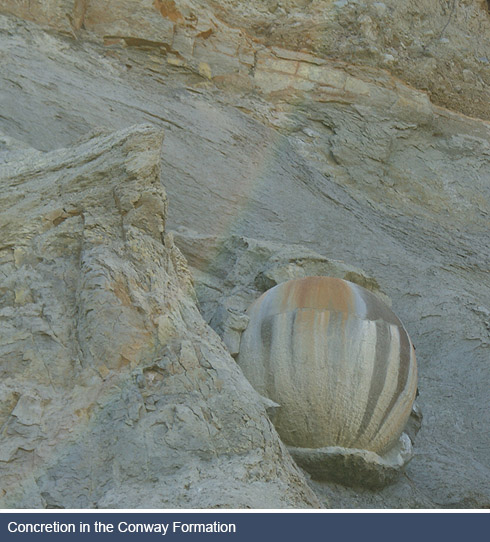

Home > Geology
Geology and fossils
- Interpretative sign at Laidmore Road (web page)
- Interpretative sign at Laidmore Road (PDF)
The Waipara River contains a number of historically and scientifically important sites, particularly in the upper reaches of the river where the sedimentary rocks contain significant information about the history of New Zealand. It is also where the first fossil bones to be discovered in New Zealand were found in 1859.
The most geologically rich areas are upstream of White Gorge, although at the Double Corner shellbeds between Wash Creek and Webbs Road several rock formations crop out, each with its own suite of fossils. These rock units form the cover sequence that was deposited on the older Torlesse basement after Zelandia (the New Zealand continent) broke away from Gondwana.
The presence of limestone indicates that the land once formed part of the seabed, as limestone is a calcareous rock formed when marine shellfish and other animals of calcite structure die. The limestone is rich in fossilised shells and skeletal debris from the plants and animlas that lived in the ancient ocean. These include marine invertebrates such as molluscs, brachiopods, bryozoans and many others.
The New Zealand Geopreservation Inventory aims to list the best examples of a wide diversity of natural and physical features and processes that characterise each part of New Zealand and document their complex geological / geomorphological history.
The Geopreservation Inventory includes five sites in the Waipara River. These sites are also recognised in the Hurunui District Plan as Significant Natural Areas (SNA). Section A7 of the District Plan sets out rules and standards for the protection of Significant Natural Areas. Rule A7.2.2 of the District Plan states that:
"No feature, tree, or vegetation in an area listed in the Schedule of Significant Natural Areas shall be damaged, removed or destroyed, except for exotic vegetation."
This effectively means that any person wishing to remove, damage or destroy any of the geological features requires resource consent to do so. Three of the sites within the Waipara River are of international scientific importance with the vulnerability of the Waipara River Cretaceous “saurian beds” being moderately vulnerable to modification by humans.
The community is concerned about the potential damage to these special sites from inappropriate vehicle use. Fossil sites and many smaller scale features cannot withstand the impact of human activities. Many of the fossilised beds are located on the banks and under the bed of the Waipara River and as such, they are particularly vulnerable to crushing and damage from motorised vehicles in these areas.

Furthermore, the location of these historically and scientifically important sites is within an area of the Waipara River that is subject to AMF Rights. Therefore, there is in actual fact no public access via Laidmore Road as this section of the river is effectively in private ownership. The only pedestrian and vehicular access to the geologically sensitive areas is across private land and as such the consent of the relevant landowners is required.
Landowners in this section of the river have a long history of cooperating with scientists, students and hobbyists wishing to study the geology and fossils, as well as with walking groups and the general public.